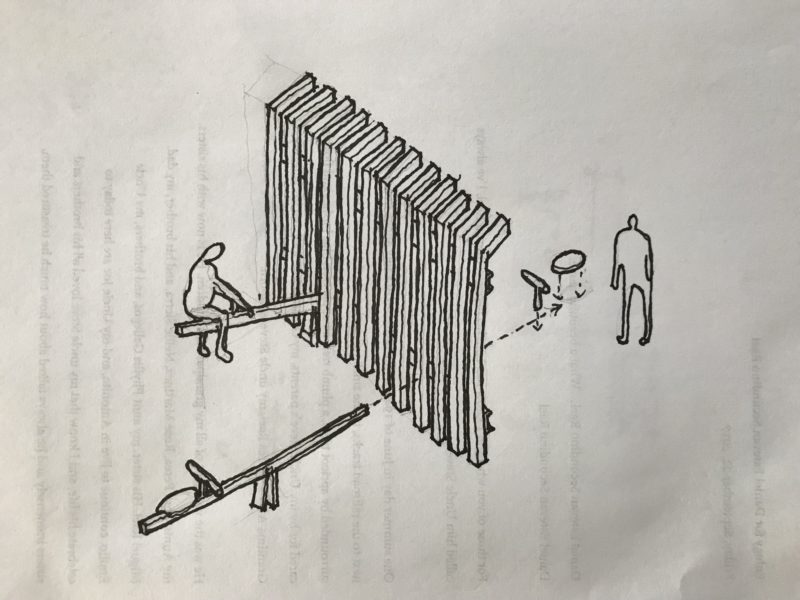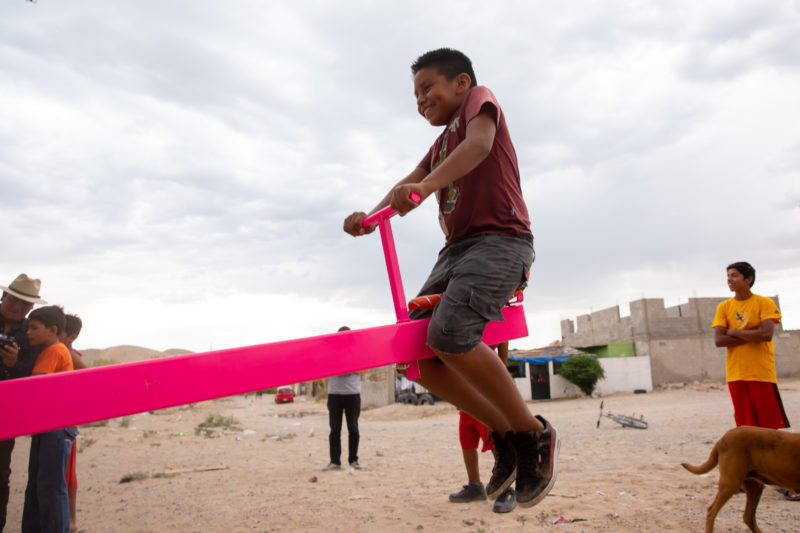
Introduction
The US-Mexico border 1 wall has become a battleground for political theater, but also various artistic interventions. One of these outstanding artworks is the pink seesaws. They went viral after they were installed by the two creative architects Ronald Rael and Virginia San Fratello 2.
Between the erect giant steel posts of the border fence lie small gaps a couple of inches apart. It is this space where they installed the seesaws.


Location
Their work is located at Sunland Park, nine miles northwest of El Paso, on the 18 feet slats border wall between Mexico 3 and the United States. It is at this site where the US Border Patrol detained about 300 migrants 45 from Mexico.

Inspiration
In 2009, the two architects came up with the idea of a seesaw on the border wall of the United States and Mexico, after reading the Secure Fence Act of 2006 67. The two started to brainstorm on different ways to subvert the concept of a border wall and its effects. The wall was supposed to join people who were separated literally by the steel wall.
Initial plans saw the erection of a large screen on both sides of the wall and beckoned the audience to watch or convert the wall into an interactive carillon.
Fast forward to January 2019; they again revisited their idea from ten years ago. They decided that their original concept, named Teeter-totter Wall, would be the most viable and easiest to pull off.


Influences
For many years, Rael and his family have been living at the borderland raised in the San Luis Valley in Colorado. He can trace his family tree back before even the state became a part of Mexico. The landscape has refined his art and caused him to have a different perspective on architecture — everything from color to location to material influences how people interact with objects.

No permission
The duo collaborated with the architectural firm Colectivo Chopekealongside steelworkers in Ciudad Juarez to construct the materials. They started to erect the wall without asking for permission or informing news outlets.
Rael, one of the designers, said in Texas Monthly 89:
It was intended to be a very humble event. We just wanted to test what it meant to bring people together along the border through design.
The installation was taken down the same day, but Rael and San Fratello are still dedicated to continuing their project. Looking ahead, the duo wants to challenge the impact the current wall has already had.
The construction of a wall dehumanizes a population. When we cut people off from neighbors or from communities, and when we damage the environment, it comes with consequences. We’re going to have to reckon with that. We want to help transform the borderlands into a place where we can heal the scars that the wall has produced.



Reactions
Shortly after erecting the wall, the duo was inundated with calls and emails, and Rael’s post on Instagram has been viewed over 200,000 times.
At first, the two didn’t know the full scale of impact the teeter-totter wall would have, and Rael, one of the architects, even conveyed shock at how sensational it has become.
One of the most incredible experiences of my and (Virginia San Fratello) career was bringing to life the conceptual drawing of the Teeter-totter Wall from 2009 in an event filled with joy, excitement, and togetherness at the border wall, he posted on social media.
While the seesaw fence drew acclaim from many people, some people were not pleased by it. Few observers saw darker undertones in the wall, with some stating that it conveyed a Pollyanna message on unity and equality or a dystopian symbol of a security-obsessed future.
One critic wrote on Twitter:
There are so many horrible things about this installation, from adding to that violent colonial wall that is desecrating indigenous land & separating families to the seesaw implying equal power relations, to human relations being mediated by the settler states of the USA and Mexico.
The original drawings and design of the Teeter-Totter Wall are currently held at the Museum of Modern Art in New York and the San Francisco Museum of Modern Art.
Video
1 min 13 sec
Analysis
Analysis
When they came up with the idea ten years ago, even before Donald Trump became president, there were already ongoing conversations regarding the border. The duo acted in response to the continued reports that the divisions are still taking place – where families were separated and immigrants locked in coops.
Rael says:
For anyone who wasn’t directly affected by it, it seems like the wall was largely invisible until Donald Trump was campaigning. Trump claimed he was going to build a wall as if one didn’t already exist. This (installation) was a much–needed recognition of what a wall does to communities on either side. I think this resonated in people’s hearts and showed the importance of humanity along the border.
When Rael and his friend San Fratello decided to create the Teeter-Totter Wall, it was not just an act of rebellion against the separation brought about by a wall. Instead, it also became a symbol of the direct consequences an action on one side has on the other.
Beyond the metaphor of the wall, the pink color also conveys a message. In the region of Ciudad Juarez, the shade of pink color used on the seesaws is highly recognized as one that commemorates the over 1500 women that have either been murdered or gone missing during the femicide 1011 since 1993.
We wanted to show the duality of the joy and sorrow in this innocent act of the play.


Conclusion
What was initially meant to separate people finally brought them together. Through the seesaws, strangers from either side of the border came together and played.
The wall became a literal fulcrum for U.S-Mexico relations, and children and adults were connected in meaningful ways on both sides with the recognition that actions that take place on one side have a direct consequence on the other side.





